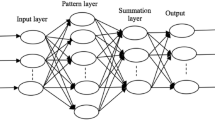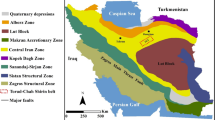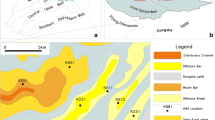Abstract
The feasibility of using multilayer perceptron (MLP), an artificial neural network, was evaluated to predict lithofacies in complex glacial deposits within the Fraser-Whatcom Basin in southwest British Columbia, Canada, and northwest Washington State, USA. Descriptions of materials from borehole logs were standardized into lithofacies using natural language processing techniques to reduce subjectivity in classification and improve automation. Three data-selection alternatives were considered to evaluate the training and prediction capabilities of MLP. Block-model representations of the subsurface were created and the best geologic realization was verified against geologic cross-sections from independent studies, evidence of hydraulic connectivity between aquifers, and the occurrence of artesian wells. Verification results showed MLP predictions were typically more generalized but produced similar subsurface trends and recreated confining units contributing to local artesian conditions. MLP appears to be a promising algorithm to solve multi-class classification for geologic modelling purposes. The workflow developed has the added benefit of being stochastic with the potential to generate multiple geologic realizations to account for uncertainty in heterogeneity.
Résumé
La faisabilité de l’utilisation du perceptron multicouche (MLP), un réseau neuronal artificiel, a été évaluée pour prédire les lithofaciès dans les dépôts glaciaires complexes du bassin Fraser-Whatcom dans le sud-ouest de la Colombie-Britannique, au Canada, et le nord-ouest de l’État de Washington, aux États-Unis d’Amérique. Les descriptions des matériaux provenant des diagraphies ont été normalisées en lithofaciès à l’aide de techniques de traitement du langage naturel afin de réduire la subjectivité de la classification et d’améliorer l’automatisation. Trois possibilités de sélection des données ont été envisagées pour évaluer les capacités d’apprentissage et de prédiction du MLP. Des représentations du sous-sol sous forme de blocs ont été créées et la meilleure réalisation géologique a été vérifiée considérant des coupes géologiques transversales provenant d’études indépendantes, la connectivité hydraulique entre les aquifères avérée et l’occurrence de puits artésiens. Les résultats de la vérification ont montré que les prédictions du MLP avaient typiquement une généralisation importante, mais qu’elles produisaient des tendances souterraines similaires et recréaient des unités de confinement contribuant aux conditions artésiennes locales. Le MLP semble être un algorithme prometteur pour résoudre la classification multi-classe à des fins de modélisation géologique. Le processus de travail mis au point présente l’avantage supplémentaire d’être stochastique, avec la possibilité de générer plusieurs réalisations géologiques pour tenir compte de l’incertitude de l’hétérogénéité.
Resumen
Se evaluó la viabilidad del uso del perceptrón multicapa (MLP), una red neuronal artificial, para predecir litofacies en depósitos glaciares complejos dentro de la cuenca Fraser-Whatcom en el suroeste de la Columbia Británica, Canadá, y el noroeste del estado de Washington, EEUU. Las descripciones de materiales de los registros de sondeos se estandarizaron en litofacies utilizando técnicas de procesamiento del lenguaje natural para reducir la subjetividad en la clasificación y mejorar la automatización. Se consideraron tres alternativas de selección de datos para evaluar las capacidades de entrenamiento y predicción del MLP. Se crearon representaciones del subsuelo mediante modelos de bloques y la mejor realización geológica se verificó con secciones geológicas de estudios independientes, pruebas de conectividad hidráulica entre acuíferos y la presencia de pozos artesianos. Los resultados de la verificación mostraron que las predicciones MLP eran típicamente más generalizadas, pero producían tendencias subsuperficiales similares y recreaban unidades de confinamiento que contribuían a las condiciones artesianas locales. MLP parece ser un algoritmo prometedor para resolver la clasificación multiclase con fines de modelización geológica. El flujo de trabajo desarrollado tiene la ventaja añadida de ser estocástico, con la posibilidad de generar múltiples realizaciones geológicas para tener en cuenta la incertidumbre en la heterogeneidad.
摘要
在加拿大不列颠哥伦比亚省西南部和美国华盛顿州西北部的Fraser-Whatcom盆地中, 评估了使用人工神经网络的多层感知器 (MLP) 方法预测复杂冰川沉积物岩相的可行性。采用自然语言处理技术将钻孔记录中的岩性描述标准化为岩相, 以减少分类的主观性并改善自动化。考虑了三种数据选择方案来评估MLP的训练和预测能力。创建了地下的块模型表示, 并通过独立研究的地质剖面、含水层之间的水力联系证据以及自流井的出现来验证最佳地质分布情况。验证结果显示, MLP的预测通常更具一般性, 但产生了类似的地下趋势, 并重新创建了导致局部自流条件的承压单元。MLP似乎是解决地质建模多类别分类问题的一种有前景的算法。开发的工作流程的附加优势是具有随机性, 有潜力生成多个地质分布以应对非均质性的不确定性。
Resumo
A viabilidade do uso do perceptron multicamadas (MLP), uma rede neural artificial, foi avaliada para prever litofáceis em depósitos glaciais complexos na Bacia de Fraser-Whatcom, no sudoeste da Colúmbia Britânica, Canadá, e no noroeste do Estado de Washington, EUA. As descrições de materiais dos registros dos furos de sondagem foram padronizadas em litofáceis usando técnicas de processamento de linguagem natural para reduzir a subjetividade na classificação e melhorar a automação. Três alternativas de seleção de dados foram consideradas para avaliar os recursos de treinamento e previsão do MLP. Foram criadas representações de modelos de blocos da subsuperfície e a melhor realização geológica foi verificada com base em seções transversais geológicas de estudos independentes, evidências de conectividade hidráulica entre aquíferos e a ocorrência de poços artesianos. Os resultados da verificação mostraram que as previsões do MLP eram normalmente mais generalizadas, mas produziam tendências semelhantes na subsuperfície e recriavam unidades de confinamento que contribuíam para as condições artesianas locais. O MLP parece ser um algoritmo promissor para resolver a classificação multiclasse para fins de modelagem geológica. O fluxo de trabalho desenvolvido tem a vantagem adicional de ser estocástico, com a possibilidade de gerar várias realizações geológicas para levar em conta a incerteza na heterogeneidade.











Similar content being viewed by others
References
Allen DM, Schuurman N, Deshpande A, Scibek J (2008) Data integration and standardization in cross-border hydrogeological studies: a novel approach to hydrostratigraphic model development. Environ Geol 53:1441–1453. https://doi.org/10.1007/s00254-007-0753-3
Anderson W, Woessner WW, Hunt RJ (2015) Applied groundwater modeling: simulation of flow and advective transport, 2nd edn. Academic, San Diego, CA
Ansah EO, Vo Thanh H, Sugai Y, Nguele R, Sasaki K (2020) Microbe-induced fluid viscosity variation: field-scale simulation, sensitivity and geological uncertainty. J Petrol Explor Prod Technol 10:1983–2003. https://doi.org/10.1007/s13202-020-00852-1
Armstrong JE (1957) Surficial geology of New Westminister map-area, British Columbia. Paper 57-5, Geological Survey of Canada, Ottawa
Armstrong JE (1976) Surficial geology, Mission, British Columbia. Map 1485A, 1 sheet, scale 1:50,000, Geological Survey of Canada. https://doi.org/10.4095/108875
Armstrong JE (1977) Surficial geology, Chilliwack, British Columbia. Map 1487A, 1 sheet, scale 1:50,000, Geological Survey of Canada. https://doi.org/10.4095/108877
Armstrong JE, Hicock SR (1979) Surficial geology, Vancouver, British Columbia. Map 1486A, 1 sheet, scale 1:50,000, Geological Survey of Canada. https://doi.org/10.4095/108876
Armstrong JE, Hicock SR (1980) Surficial geology, New Westminister, British Columbia. Map 1484A, 1 sheet, scale 1:50,000, Geological Survey of Canada. https://doi.org/10.4095/108874
Ayachit U (2015) The paraview guide: a parallel visualization application. Kitware, Inc., USA
Baykan NA, Yilmaz N (2010) Mineral identification using color spaces and artificial neural networks. Comput Geosci 36:91–97. https://doi.org/10.1016/j.cageo.2009.04.009
Bayless ER, Arihood LD, Reeves HW, Sperl BJS, Qi SL, Stipe VE, Bunch AR (2017) Maps and grids of hydrogeologic information created from standardized water-well drillers’ records of the glaciated United States. US Geol Surv Sci Invest Rep 2015-5105. https://doi.org/10.3133/sir20155105
Bergstra J, Yamins D, Cox DD (2013) Making a science of model search: hyperparameter optimization in hundreds of dimensions for vision architectures. Proc. of the 30th International Conference on Machine Learning (ICML 2013), Atlanta, GA, June 2013
Bianchi M, Kearsey T, Kingdon A (2015) Integrating deterministic lithostratigraphic models in stochastic realizations of subsurface heterogeneity: impact on predictions of lithology, hydraulic heads and groundwater fluxes. J Hydrol 531:557–573. https://doi.org/10.1016/j.jhydrol.2015.10.072
British Columbia Ministry of Environment and Climate Change Strategy (BCMECC) (2016a) Aquifer classification worksheet (aquifer reference number: 33). https://s3.ca-central-1.amazonaws.com/aquifer-docs/00000/AQ_00033_Aquifer_Mapping_Report.pdf. Accessed March 2019
British Columbia Ministry of Environment and Climate Change Strategy (BCMECC) (2016b) Aquifer classification worksheet (aquifer reference number: 58). https://s3.ca-central-1.amazonaws.com/aquifer-docs/00000/AQ_00058_Aquifer_Mapping_Report.pdf. Accessed March 2019
British Columbia Ministry of Environment and Climate Change Strategy (BCMECC) (2016d) Ground water aquifers. https://catalogue.data.gov.bc.ca/dataset/ground-water-aquifers. Accessed March 2019
British Columbia Ministry of Forests, Lands, Natural Resource Operations and Rural Development (2018) Well drilling advisory flowing artesian conditions: Surrey and Langley, BC. https://www2.gov.bc.ca/assets/gov/environment/air-land-water/water/water-wells/surrey_and_langley_bc.pdf. Accessed March 2019
Brownlee J (2022) How to improve deep learning performance. Machine Learning Mastery. https://machinelearningmastery.com/improve-deep-learning-performance/. Accessed August 2022
Canadian Hydrographic Service (2019) NONNA bathymetric data. https://www.charts.gc.ca/data-gestion/resourcemaps-cartesressources-eng.html. Accessed December 2019
Clague JJ (1991) Quaternary stratigraphy and history of south-coastal British Columbia. In: Monger JWH (ed) Geology and geological hazards of the Vancouver region, southwestern British Columbia. Geol Surv Can Bull 481:181–192
Cracknell MJ, Reading AM (2014) Geological mapping using remote sensing data: a comparison of five machine learning algorithms, their response to variations in the spatial distribution of training data and the use of explicit spatial information. Comput Geosci 63:22–33. https://doi.org/10.1016/j.cageo.2013.10.008
Cummings DI, Russell HAJ, Sharpe DR (2012) Buried-valley aquifers in the Canadian prairies: geology, hydrogeology, and origin. Earth Science Sector (ESS) Contribution 20120131. Can J Earth Sci 49(9):987–1004. https://doi.org/10.1139/e2012-041
DMTI Spatial Inc. (2002) Digital elevation model (DEM). NAD83, UTM projection, 30 m resolution from 1:50,000 scale digital mapping. SFU Library. Accessed on December 2019
Dunn D, Ricketts B (1994) Surficial geology of Fraser Lowlands digitized from GSC Maps 1484A, 1485A, 1486A, and 1487A (92 G/1, 2, 3, 6, 7; 92 H/4). Geol Surv Can Open File 2894. https://doi.org/10.4095/194084
Easterbrook DJ (1986) Stratigraphy and chronology of Quaternary deposits of the Puget Lowland and Olympic Mountains of Washington and the Cascade Mountains of Washington and Oregon. Quatern Sci Rev 5:145–159. https://doi.org/10.1016/0277-3791(86)90180-0
Eungard DW (2014) Models of bedrock elevation and unconsolidated sediment thickness in Puget Lowland, Washington. US Geol Surv Open-File Rep 2014-04. https://doi.org/10.3133/ofr20181115
Finlayson DP, Haugerud RA, Greenberg H, Logsdon MG (2000) Puget Sound digital elevation model. University of Washington. https://www.ocean.washington.edu/data/pugetsound/asciigrid.html. Accessed December 2019
Frind EO, Molson JW, Sousa MR, Martin PJ (2014) Insights from four decades of model development on the Waterloo Moraine: a review. Can Water Resour J 39(2):149–166. https://doi.org/10.1080/07011784.2014.914799
Fuentes I, Padarian J, Iwanaga T, Vervoort RW (2020) 3D lithological mapping of borehole descriptions using word embeddings. Comput Geosci 141:104516. https://doi.org/10.1016/j.cageo.2020.104516
Golder Associates (Golder) (2005) Comprehensive groundwater modelling assignment, Township of Langley. Prepared for the Township of Langley, BC
Haj AE, Soller DR, Reddy JE, Kauffman LJ, Yager RM, Buchwald CA (2018) Hydrogeologic framework for characterization and occurrence of confined and unconfined aquifers in quaternary sediments in the glaciated conterminous United States: a digital map compilation and database. US Geol Surv Data Series 1090. https://doi.org/10.3133/ds1090
Halstead EC (1986) Ground water supply: Fraser Lowland, British Columbia. Scientific series, Canada Inland Waters Directorate, no. 145, NHRI paper no. 26, NHRI, Ontario
Hamilton TS, Ricketts BD (1994) Contour Map of the Sub-Quaternary Bedrock Surface, Strait of Georgia and Fraser Lowland. Geol Surv Can Bull 481:193–196
He X, Sonnenborg TO, Jørgensen F, Høyer AS, Møller RR, Jensen KH (2013) Analyzing the effects of geological and parameter uncertainty on prediction of groundwater head and travel time. Hydrol Earth Syst Sci 17:3245–3260. https://doi.org/10.5194/hess-17-3245-2013
Johnson B, Allen DM, Wei M (2022) Mapping the likelihood of flowing artesian conditions in the Okanagan Basin and Fraser Valley, British Columbia. Water Science Series, Province of British Columbia, Victoria, BC
Jones MA (1999) Geologic framework for the Puget Sound Aquifer System, Washington and British Columbia. US Geol Surv Pap 1424-C. https://doi.org/10.3133/pp1424C
Jørgensen F, Høyer AS, Sandersen PBE, He X, Foged N (2015) Combining 3D geological modelling techniques to address variations in geology, data type and density: an example from Southern Denmark. Comput Geosci 81:53–63. https://doi.org/10.1016/J.CAGEO.2015.04.010
Kanevski M, Pozdnoukhov A, Timonin V (2009) Machine learning for spatial environmental data, 1st edn. EPFL Press, Lausanne, Switzerland. https://doi.org/10.1201/9781439808085
Kearsey T, Williams J, Finlayson A, Williamson P, Dobbs M, Marchant B, Kingdon M, Campbell D (2015) Testing the application and limitation of stochastic simulations to predict the lithology of glacial and fluvial deposits in central Glasgow, UK. Eng Geol 187:98–112. https://doi.org/10.1016/j.enggeo.2014.12.017
Kovanen DJ (2002) Morphologic and stratigraphic evidence for Allerod and Younger Dryas age glacier fluctuations of the Cordilleran Ice Sheet, British Columbia, Canada and Northwest Washington, U.S.A. Boreas 31:163–184
Kovanen DJ, Slaymaker O (2015) The paraglacial geomorphology of the Fraser Lowland, southwest British Columbia and northwest Washington. Geomorphology 232:78–93. https://doi.org/10.1016/j.geomorph.2014.12.021
Lukjan A, Swasdi S, Chalermyanont T (2016) Importance of alternative conceptual model for sustainable groundwater management of the Hat Yai Basin, Thailand. Procedia Eng 154:308–316. https://doi.org/10.1016/j.proeng.2016.07.480
Morgan SE (2018) Investigating the role of buried valley aquifer systems in the regional hydrogeology of the Central Peace Region in Northeast British Columbia. MSc Thesis, Simon Fraser University, BC, Canada. http://summit.sfu.ca/item/17906
Mustard PS, Rouse GE (1994) Stratigraphy and evolution of Tertiary Georgia Basin and subjacent Upper Cretaceous sedimentary rocks, southwestern British Columbia and northwestern Washington State. In: Monger JWH (ed) Geology and geologic hazards of the Vancouver region, southwestern British Columbia. Geol Surv Can Bull 481:97–169
Padarian J, Fuentes I (2019) Word embeddings for application in geosciences: development, evaluation, and examples of soil-related concepts. Soil 5:177–187. https://doi.org/10.5194/soil-5-177-2019
Pasanen AH, Okkonen JS (2017) 3D Geological models to groundwater flow models: data Integration between GSI3D and groundwater flow modelling software GMS and FeFlow®. Geol Soc Spec Publ 408(1):71–87. https://doi.org/10.1144/SP408.15
Pedregosa F, Varoquaux G, Gramfort A, Michel V, Thirion B, Grisel O, Blondel M, Prettenhofer P, Weiss R, Dubourg V, Vanderplas J, Passos A, Cournapeau D, Brucher M, Perrot M, Duchesnay E (2011) Scikit-learn: machine learning in Python. J Mach Learn Res 12:2825–2830. https://doi.org/10.48550/arXiv.1201.0490
Poeter E, Anderson D (2005) Multimodel ranking and inference in ground water modeling. Ground Water 43(4):597–605. https://doi.org/10.1111/j.1745-6584.2005.0061.x
Rajaee T, Ebrahimi H, Nourani V (2019) A review of the artificial intelligence methods in groundwater level modeling. J Hydrol 572:336–351. https://doi.org/10.1016/j.jhydrol.2018.12.037
Refsgaard JC, Christensen S, Sonnenborg TO, Seifert D, Højberg AL, Troldborg L (2012) Review of strategies for handling geological uncertainty in groundwater flow and transport modeling. Adv Water Resour 36:36–50. https://doi.org/10.1016/j.advwatres.2011.04.006
Rizzo DM, Dougherty DE (1994) Characterization of aquifer properties using artificial neural networks: neural kriging. Water Resour Res 30(2):483–497. https://doi.org/10.1029/93WR02477
Russell HAJ, Brennand TA, Logan C, Sharpe DR (1998) Standardization and assessment of geological descriptors from water well records, Greater Toronto and Oak Ridges Moraine areas, southern Ontario. Geol Surv Can Current Res 1998-E:89–102. https://doi.org/10.4095/209956
Sahoo S, Jha MK (2017) Pattern recognition in lithology classification: modeling using neural networks, self-organizing maps and genetic algorithms. Hydrogeol J 25(2):311–330. https://doi.org/10.1007/s10040-016-1478-8
Schorpp L, Straubhaar J, Renard P (2022) Automated hierarchical 3D modeling of quaternary aquifers: the ArchPy approach. Front Earth Sci 10:884075. https://doi.org/10.3389/feart.2022.884075
Standard, A.S.T.M. (2011) D2487-11 standard practice for classification of soils for engineering purposes (Unified Soil Classification System). ASTM Int., West Conshohocken, PA
Sullivan CB, Kaszynski A (2019) PyVista: 3D plotting and mesh analysis through a streamlined interface for the Visualization Toolkit (VTK). J Open Source Softw 4(37):1450. https://doi.org/10.21105/joss.01450
Toth A, Havril T, Simon S, Galsa A, Santos FAM, Muller I, Madl-Szonyi J (2016) Groundwater flow pattern and related environmental phenomena in complex geologic settings based on integrated model construction. J Hydrol 539:330–344. https://doi.org/10.1016/j.hydrol.2016.05.038
United States Geologic Survey (2019) National Elevation Dataset (NED). https://gdg.sc.egov.usda.gov/Catalog/ProductDescription/NED.html. Accessed July 2019
Vaccaro JJ (1992) Plan of study for the Puget-Willamette lowland regional aquifer system analysis, Western Washington and Western Oregon. US Geol Surv Water Resour Invest Rep 91-4189. https://doi.org/10.3133/wri914189
Vaccaro JJ, Hansen AJ, Jones MA (1998) Hydrogeologic framework of the Puget Sound Aquifer System. US Geol Surv Prof Pap 1424–D. https://doi.org/10.3133/pp1424D
Vettigli G (2018) MiniSom: minimalistic and NumPy-based implementation of the self organizing map. https://github.com/JustGlowing/minisom/. Accessed May 2020
Vo Thanh H, Sugai Y, Nguele R, Sasaki K (2019) Integrated workflow in 3D geological model construction for evaluation of CO2 storage capacity of a fractured basement reservoir in Cuu Long Basin, Vietnam. Int J Greenh Gas Control 90:102826. /https://doi.org/10.1016/j.ijggc.2019.102826
Ward BC, Thomson B (2004) Late Pleistocene stratigraphy and chronology of lower Chehalis River Valley, southwestern British Columbia: evidence for a restricted Coquitlam Stade. Can J Earth Sci 41(7):881–895. https://doi.org/10.1139/e04-037
Washington Division of Geology and Earth Resources (2016) Surface geology, 1:100,000: GIS data. Washington Division of Geology and Earth Resources Digital Data Series DS-18, version 3.1, Washington Division of Geology and Earth Resources, Olympia, WA
Yager RM, Kauffman LJ, Soller DR, Haj AE, Heisig PM, Buchwald CA, Westenbroek SM, Reddy JE (2019) Characterization and occurrence of confined and unconfined aquifers in Quaternary sediments in the glaciated conterminous United States (ver. 1.1). US Geol Ssurv Sci Invest Rep 2018-5091. https://doi.org/10.3133/sir20185091
Acknowledgements
This research was supported by a Natural Sciences and Engineering Research Council (NSERC) Discovery Grant to D. Allen.
Author information
Authors and Affiliations
Corresponding author
Ethics declarations
Conflict of Interest
On behalf of all authors, Zidra Hammond states that there is no conflict of interest.
Additional information
Publisher’s Note
Springer Nature remains neutral with regard to jurisdictional claims in published maps and institutional affiliations.
Supplementary Information
Below is the link to the electronic supplementary material.
Rights and permissions
Springer Nature or its licensor (e.g. a society or other partner) holds exclusive rights to this article under a publishing agreement with the author(s) or other rightsholder(s); author self-archiving of the accepted manuscript version of this article is solely governed by the terms of such publishing agreement and applicable law.
About this article
Cite this article
Hammond, Z., Allen, D.M. Evaluating the feasibility of using artificial neural networks to predict lithofacies in complex glacial deposits. Hydrogeol J 32, 509–526 (2024). https://doi.org/10.1007/s10040-023-02726-2
Received:
Accepted:
Published:
Issue Date:
DOI: https://doi.org/10.1007/s10040-023-02726-2




